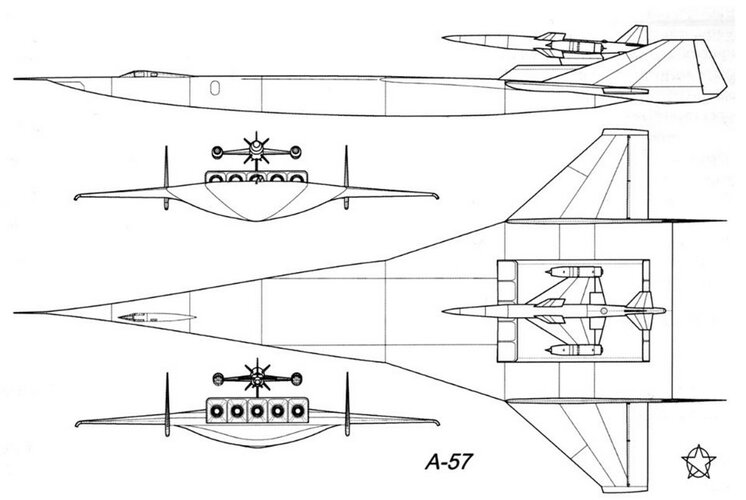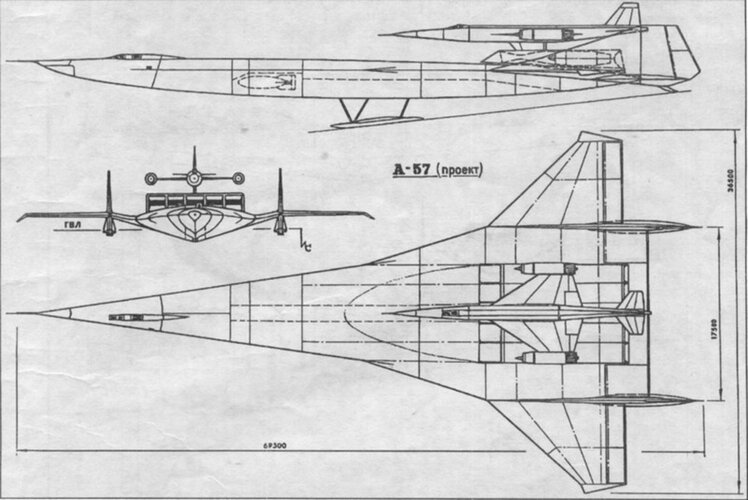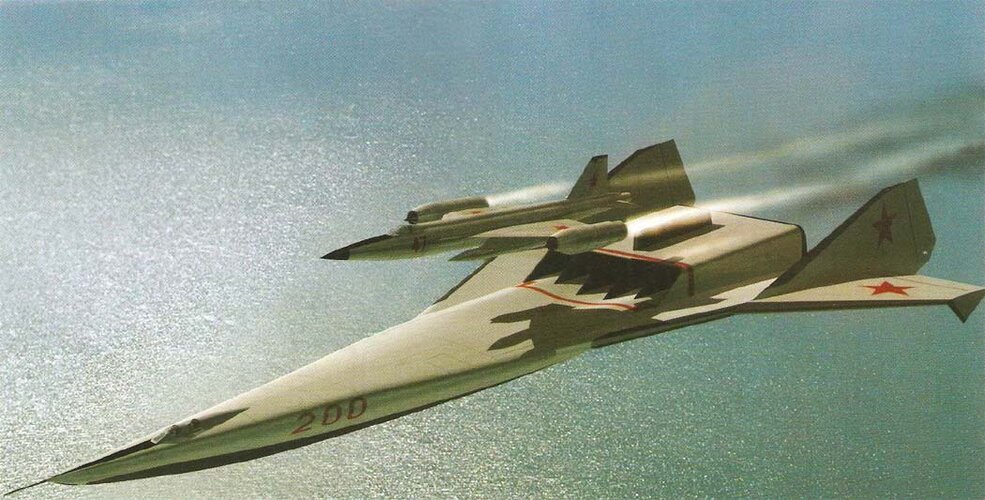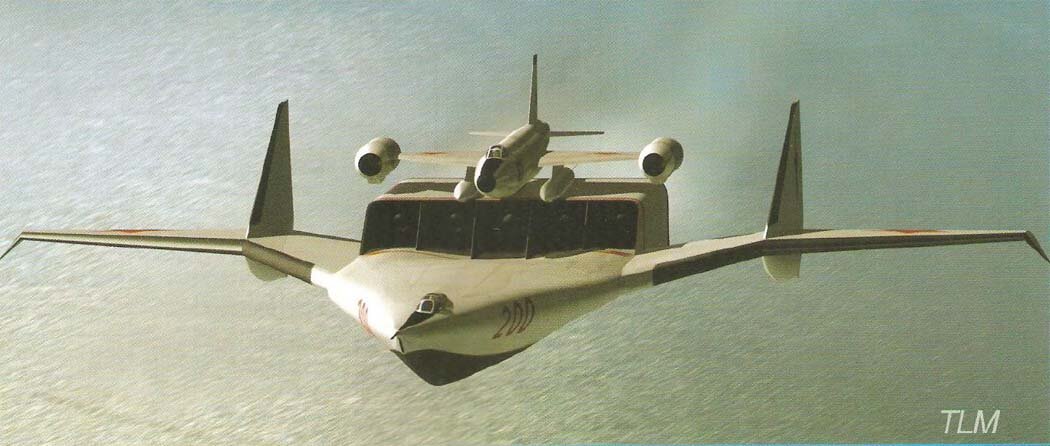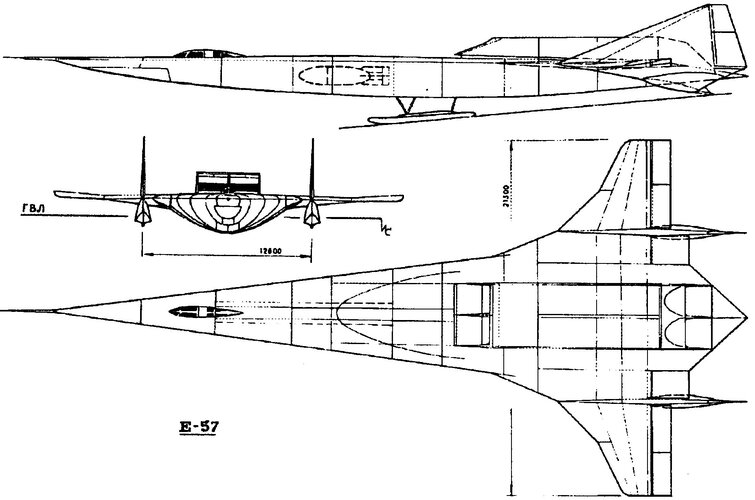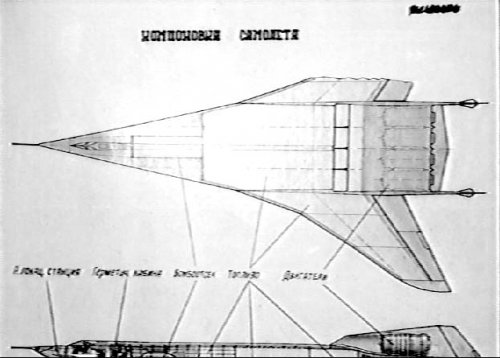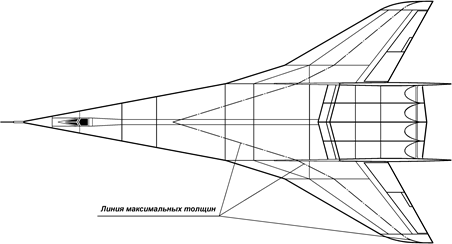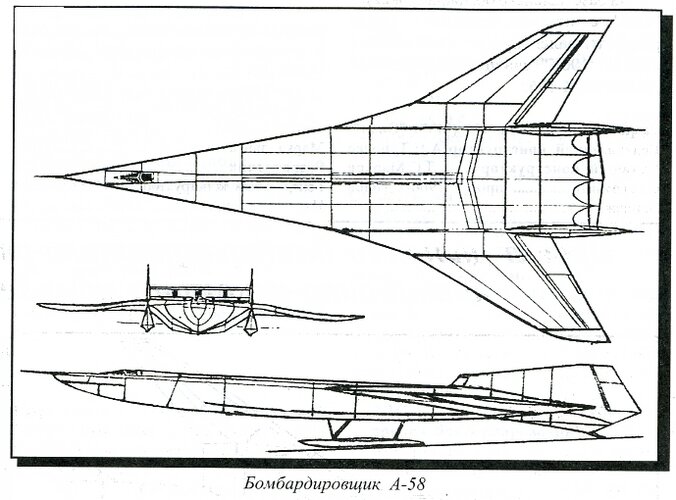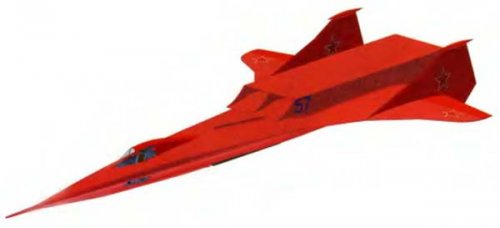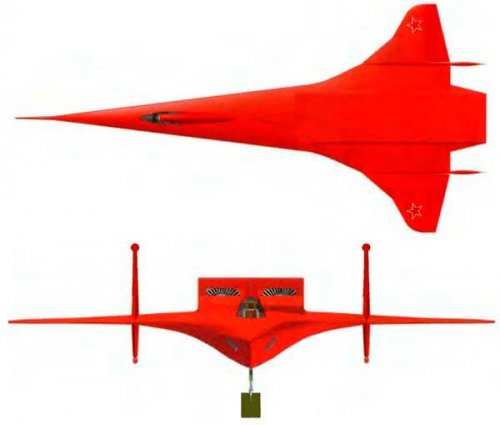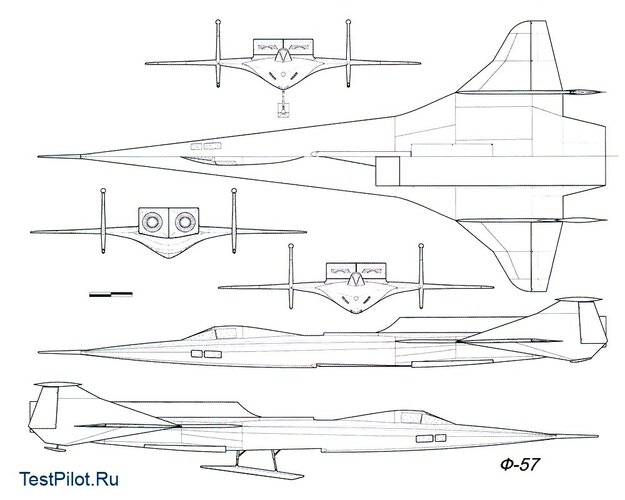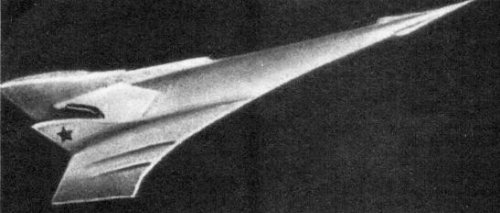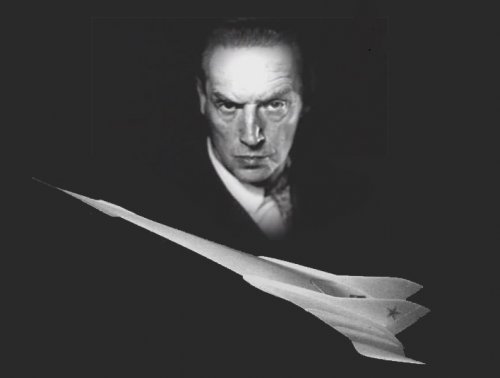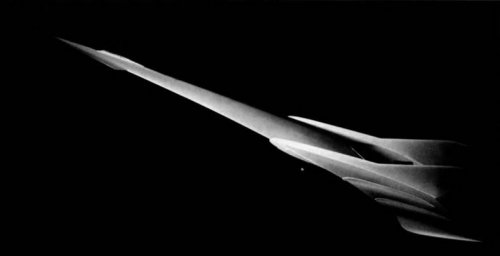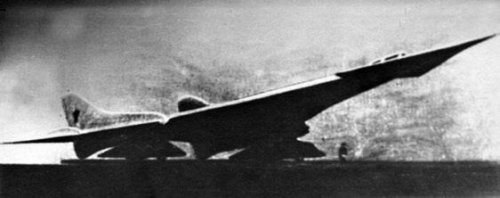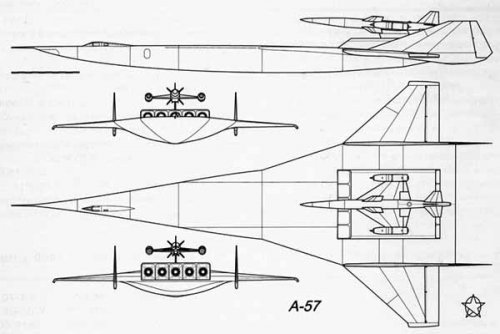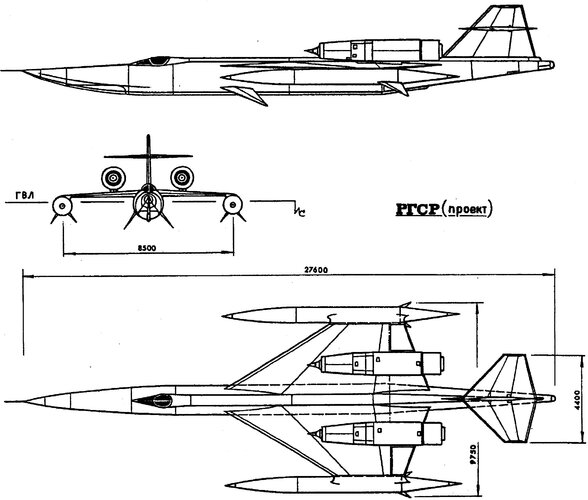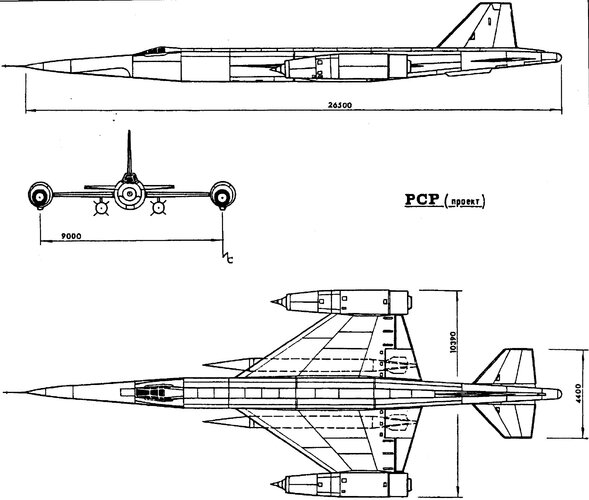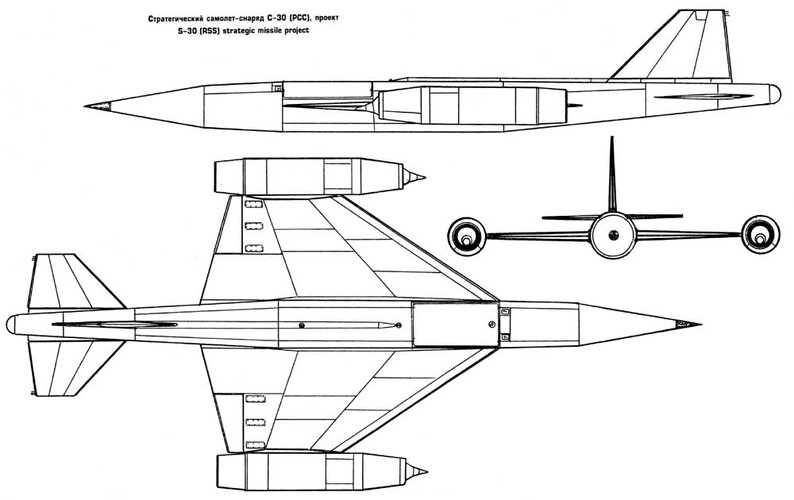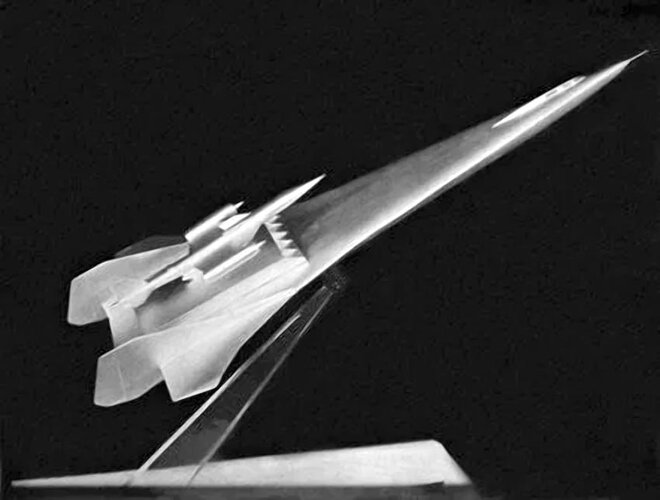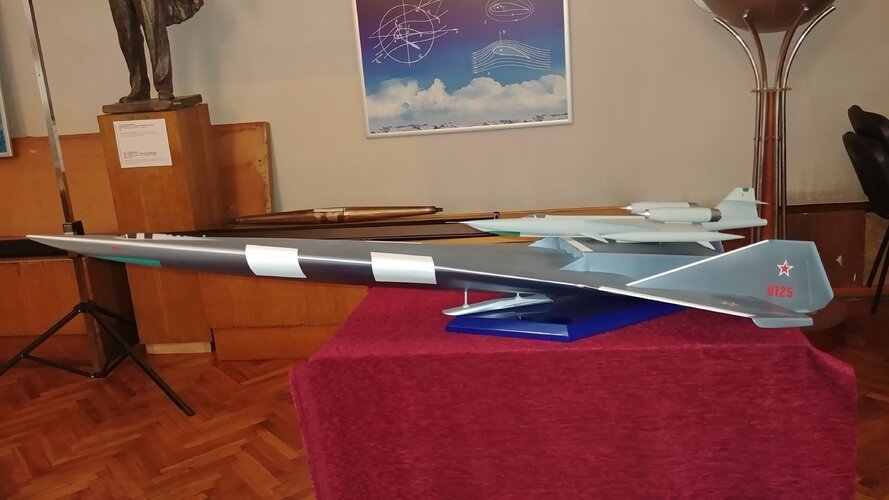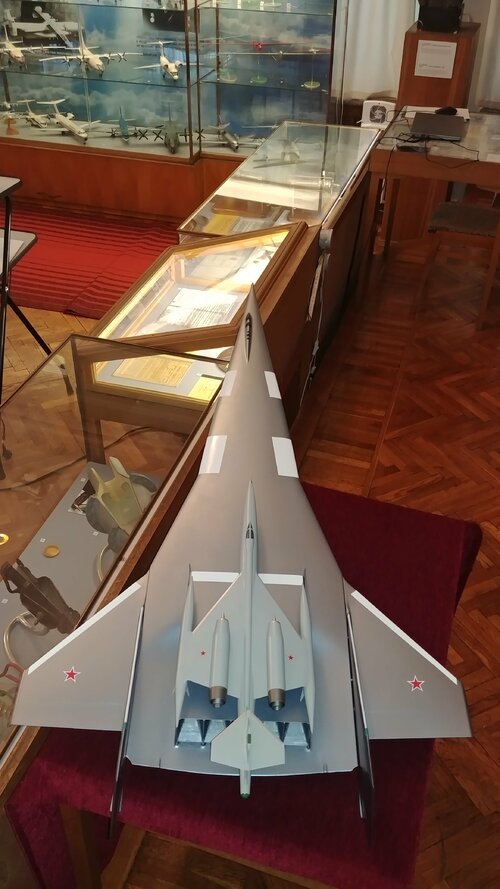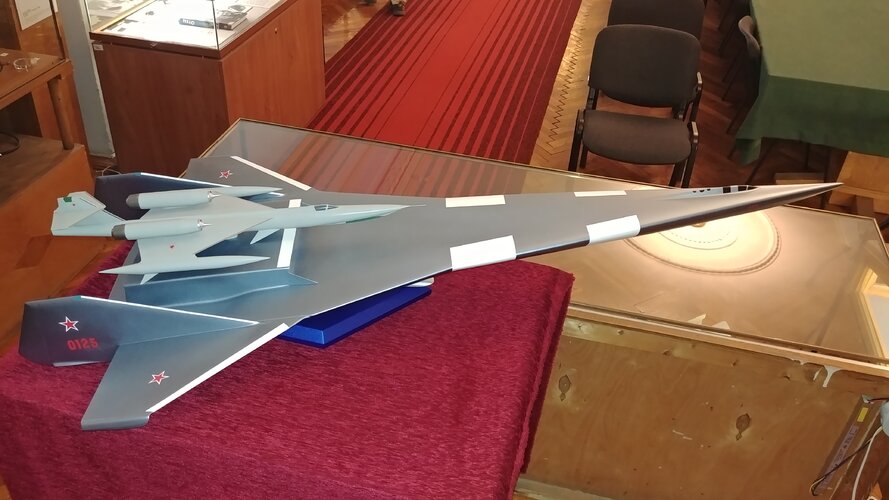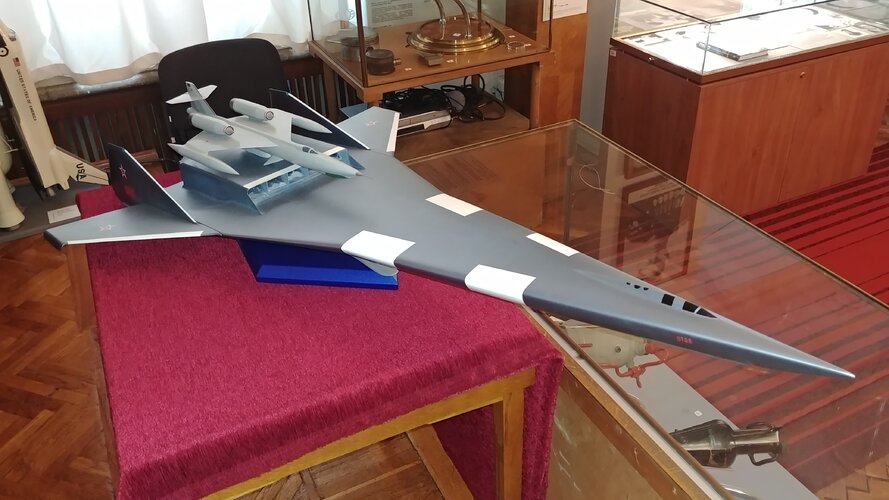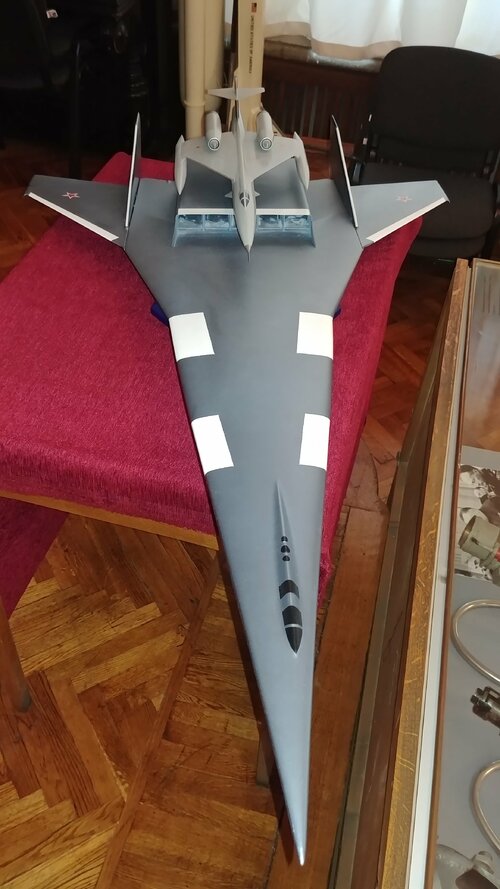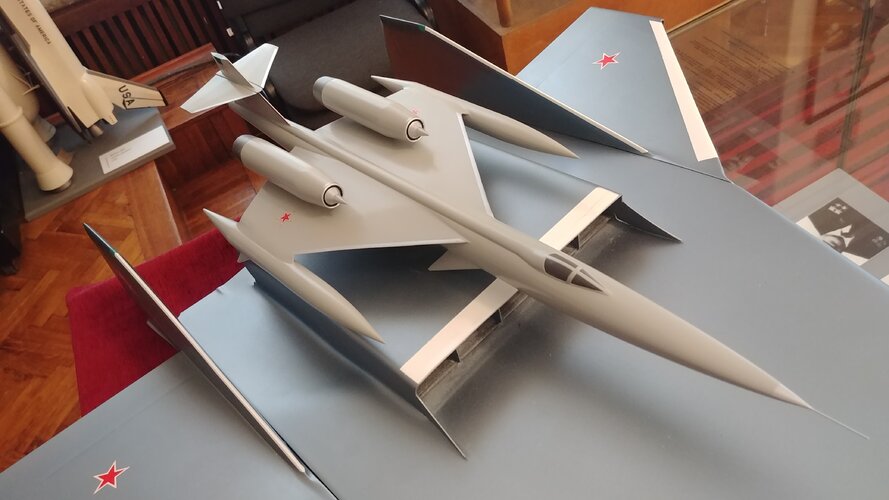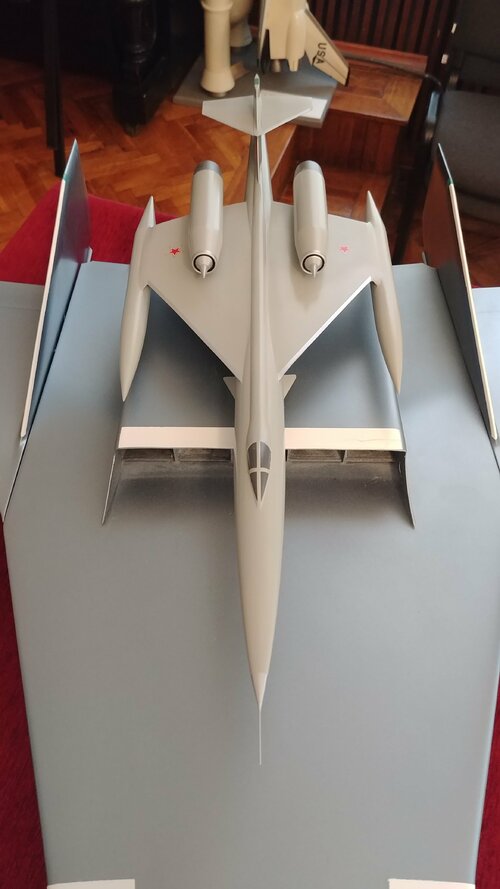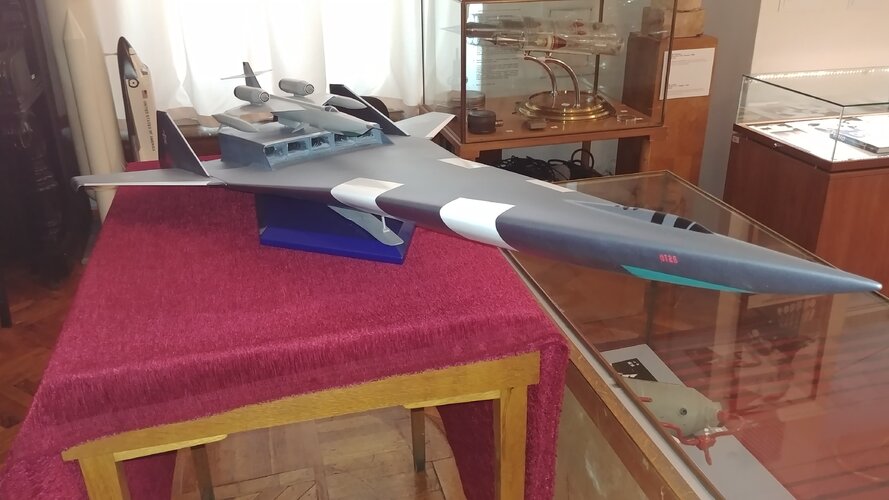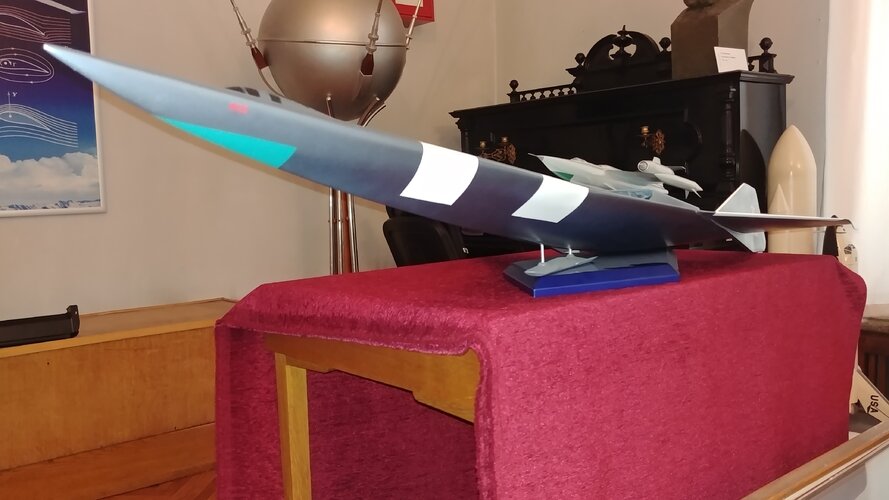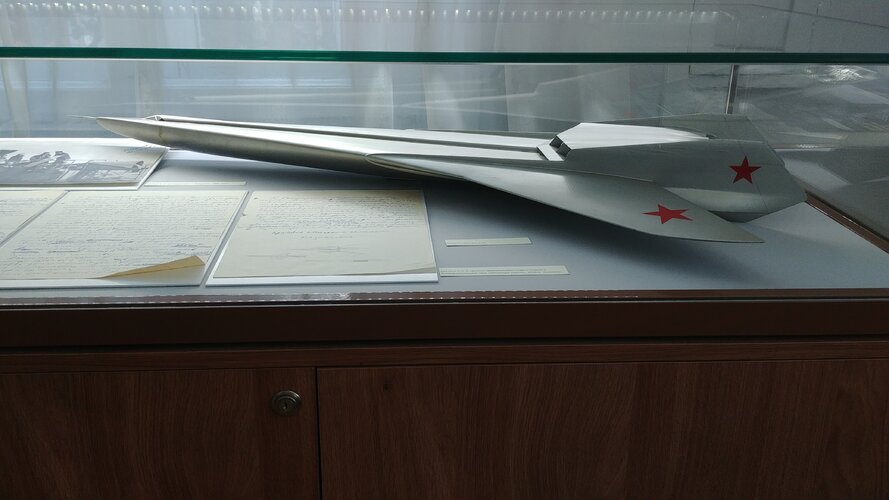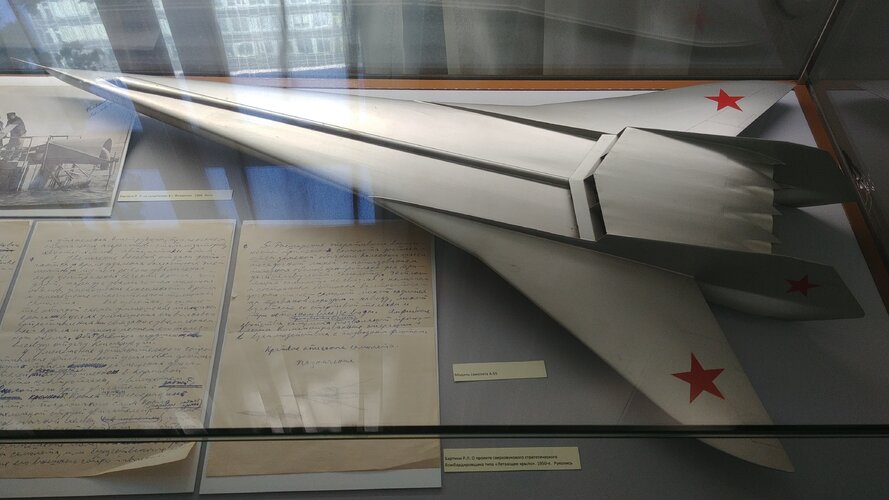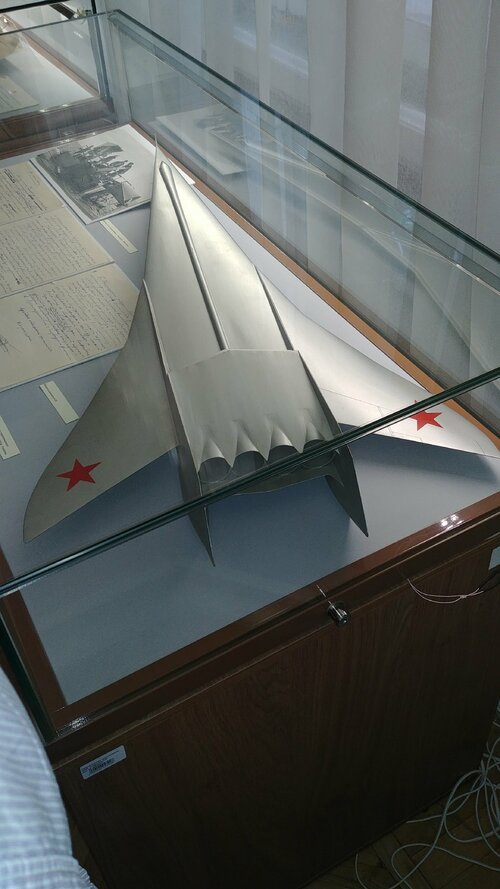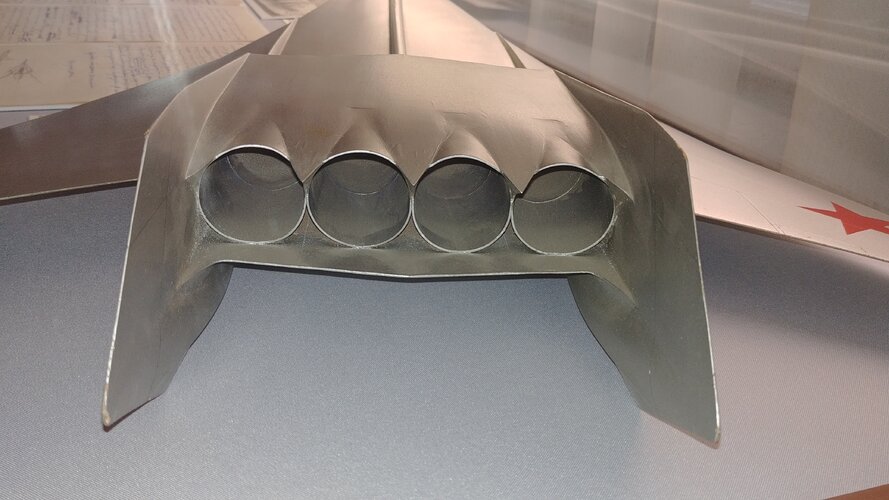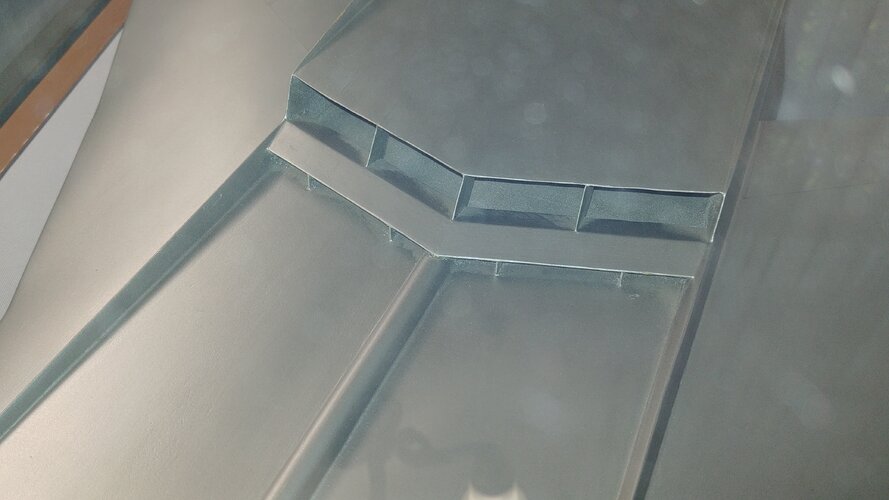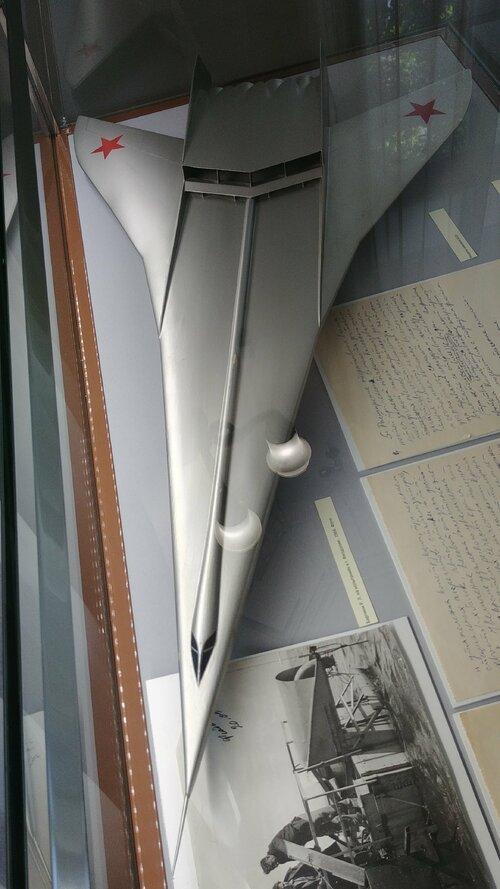blackkite
Don't laugh, don't cry, don't even curse, but.....
- Joined
- 31 May 2007
- Messages
- 8,808
- Reaction score
- 7,684
Bartini А-57
In 1952, Robert Ludvigovich Bartini, head of the department of advanced schemes of the S.A. Chaplygin Siberian Aviation Research Institute (SibNIA; Novosibirsk), creates a project for the T-203 aircraft.
Being an excellent mathematician, he literally "calculated" the scheme of an aircraft with a variable wing along the leading edge of the sweep.
Without particularly expensive purges and substantial costs.
R.L. Bartini's project, presented in 1955, planned the creation of a supersonic flying medium-range bomber boat A-55. The seaplane had the ability to replenish fuel supplies in the ocean, in the immediate vicinity of the enemy's shores, from surface ships and submarines. In addition, seaplanes did not require huge airfields with heavy-duty multi-kilometer concrete runways, which were excellent targets for enemy strike weapons. The project was initially rejected because the declared characteristics were considered unrealistic. The appeal to S.P. Korolev helped, who helped to justify the project experimentally. Dozens of models with different wing options were manufactured and blown.
To continue working on the project, R.L.Bartini in April 1957 was seconded from SIBNIA to OKBS MAP (Moscow).
The teams of TsAGI and TsIAM are involved in work on the strategic A-57.
The modes of takeoff from water and the possibility of its long stay afloat were investigated.
The A-57 aircraft was a strategic integrated system, including the amphibious seaplane itself, capable of taking off and landing on the water surface, as well as on snow and ice (this made it possible to use forward-based airfields located in the Arctic on drifting ice floes), and a heavy controlled rocket projectile RCC, created in the OKB P.V.Tsybin and located on the carrier plane.
The aircraft was supposed to be made according to the "tailless" scheme with a pronounced integral layout (the fuselage itself was practically absent). The "self-balancing" wing (balancing was achieved by twisting in span) with a minimum total wave and inductive resistance, having a variable sweep along the leading edge, had a supercritical downward-convex profile in the center, and a convex upward one at the ends. There was no wheeled landing gear, takeoff and landing on ice and water were performed using a hydro-ski retractable under the central part of the aircraft. For takeoff from a conventional airfield, it was supposed to use wheeled carts dropped after taking off from the ground. The aircraft's crew consisted of three people.
The A-57 was supposed to carry the equipment necessary for autonomous operation in the ocean or on the Arctic ice: there was the necessary skipper equipment, a through passage along the entire boat, and a latrine for the crew.
All operations for the priority maintenance of the bomber were carried out within the wing contours and vertical tail, i.e. the aircraft could be serviced afloat.
At that time, the equipment of a flying boat was the height of perfection: the SVR-1 radar, the active ROSA and Venik systems, the TRS-45 passive jamming system, the Veter navigation complex, the Planeta communication complex and the hydroacoustic communication system with submarines "Okhotsk".
The design maximum speed of the A-57 was 2500 km / h, the service ceiling (depending on the flight weight) was 18000-23000 m, the practical range was 15000 km. The aircraft with a takeoff weight of 250 tons was supposed to be equipped with five NK-10B turbojet engines (5 x 26,000 kgf) or, temporarily, NK-6 (5 x 22,500 kgf), placed with a package installed above the hull of the boat, in its tail section between the keels, inclined inward. Above the engines, a cruise missile RSS was to be installed, in addition, there was an internal thermostabilized bomb bay to accommodate a thermonuclear bomb "244H" weighing 3000 kg.
The MAP commission, which was attended by representatives of TsAGI, TsIAM, NII-1, OKB-156 (A.N. Tupolev) and OKB-23 (V.M. Myasishcheva), gave a positive opinion on the project, but the government decision to build the plane was never accepted.
In total, from 1952 to 1961 R.L. Bartini worked on five projects of supersonic amphibious aircraft, made according to the tailless scheme - A-55, A-57, R, F-57 (R-57) and R-57AL, which were supposed to install the NK-6 engines, NK-10 or VK-15M.
R-57 is a front-line supersonic amphibious bomber with a ski landing gear.
A-58 - Nuclear marine bomber.
On LTH it is close to Tu-16, Tu-22.
The scheme and design is identical to the A-57.
Amphibian.
In 1961, the designer presented the project of the R-57-AL supersonic long-range reconnaissance aircraft - the development of the A-57 with a nuclear power plant
http://www.airwar.ru/enc/xplane/a57.html
In 1952, Robert Ludvigovich Bartini, head of the department of advanced schemes of the S.A. Chaplygin Siberian Aviation Research Institute (SibNIA; Novosibirsk), creates a project for the T-203 aircraft.
Being an excellent mathematician, he literally "calculated" the scheme of an aircraft with a variable wing along the leading edge of the sweep.
Without particularly expensive purges and substantial costs.
R.L. Bartini's project, presented in 1955, planned the creation of a supersonic flying medium-range bomber boat A-55. The seaplane had the ability to replenish fuel supplies in the ocean, in the immediate vicinity of the enemy's shores, from surface ships and submarines. In addition, seaplanes did not require huge airfields with heavy-duty multi-kilometer concrete runways, which were excellent targets for enemy strike weapons. The project was initially rejected because the declared characteristics were considered unrealistic. The appeal to S.P. Korolev helped, who helped to justify the project experimentally. Dozens of models with different wing options were manufactured and blown.
To continue working on the project, R.L.Bartini in April 1957 was seconded from SIBNIA to OKBS MAP (Moscow).
The teams of TsAGI and TsIAM are involved in work on the strategic A-57.
The modes of takeoff from water and the possibility of its long stay afloat were investigated.
The A-57 aircraft was a strategic integrated system, including the amphibious seaplane itself, capable of taking off and landing on the water surface, as well as on snow and ice (this made it possible to use forward-based airfields located in the Arctic on drifting ice floes), and a heavy controlled rocket projectile RCC, created in the OKB P.V.Tsybin and located on the carrier plane.
The aircraft was supposed to be made according to the "tailless" scheme with a pronounced integral layout (the fuselage itself was practically absent). The "self-balancing" wing (balancing was achieved by twisting in span) with a minimum total wave and inductive resistance, having a variable sweep along the leading edge, had a supercritical downward-convex profile in the center, and a convex upward one at the ends. There was no wheeled landing gear, takeoff and landing on ice and water were performed using a hydro-ski retractable under the central part of the aircraft. For takeoff from a conventional airfield, it was supposed to use wheeled carts dropped after taking off from the ground. The aircraft's crew consisted of three people.
The A-57 was supposed to carry the equipment necessary for autonomous operation in the ocean or on the Arctic ice: there was the necessary skipper equipment, a through passage along the entire boat, and a latrine for the crew.
All operations for the priority maintenance of the bomber were carried out within the wing contours and vertical tail, i.e. the aircraft could be serviced afloat.
At that time, the equipment of a flying boat was the height of perfection: the SVR-1 radar, the active ROSA and Venik systems, the TRS-45 passive jamming system, the Veter navigation complex, the Planeta communication complex and the hydroacoustic communication system with submarines "Okhotsk".
The design maximum speed of the A-57 was 2500 km / h, the service ceiling (depending on the flight weight) was 18000-23000 m, the practical range was 15000 km. The aircraft with a takeoff weight of 250 tons was supposed to be equipped with five NK-10B turbojet engines (5 x 26,000 kgf) or, temporarily, NK-6 (5 x 22,500 kgf), placed with a package installed above the hull of the boat, in its tail section between the keels, inclined inward. Above the engines, a cruise missile RSS was to be installed, in addition, there was an internal thermostabilized bomb bay to accommodate a thermonuclear bomb "244H" weighing 3000 kg.
The MAP commission, which was attended by representatives of TsAGI, TsIAM, NII-1, OKB-156 (A.N. Tupolev) and OKB-23 (V.M. Myasishcheva), gave a positive opinion on the project, but the government decision to build the plane was never accepted.
In total, from 1952 to 1961 R.L. Bartini worked on five projects of supersonic amphibious aircraft, made according to the tailless scheme - A-55, A-57, R, F-57 (R-57) and R-57AL, which were supposed to install the NK-6 engines, NK-10 or VK-15M.
R-57 is a front-line supersonic amphibious bomber with a ski landing gear.
A-58 - Nuclear marine bomber.
On LTH it is close to Tu-16, Tu-22.
The scheme and design is identical to the A-57.
Amphibian.
In 1961, the designer presented the project of the R-57-AL supersonic long-range reconnaissance aircraft - the development of the A-57 with a nuclear power plant
http://www.airwar.ru/enc/xplane/a57.html
Attachments
Last edited:

